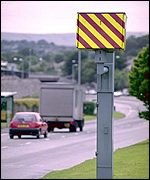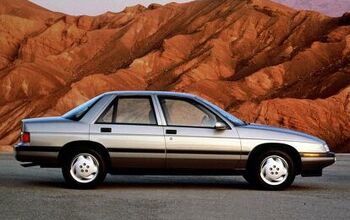Freeze Frame
Automatic speed cameras have dotted European highways for well over a decade– despite the fact that there's no conclusive proof that they improve safety. In fact, an official British government report recently stated 'No significant difference was observed in the personal injury accident rate for sites with and without speed cameras.' And yet the bane of European roadways is coming to a freeway near you. By the time spring arrives, at least two US states will install photo radar cameras on their highways, issuing millions of dollars worth of fines to hapless motorists.
In October, the Scottsdale, Arizona City Council approved a plan to place photo radar cameras on Loop 101, a freeway that encompasses the Phoenix metropolitan area. It's a no-brainer for Arizona Governor Janet Napolitano; under the plan, the state takes a 46 percent cut of the estimated $22 million annual haul while Scottsdale bears all the political risk. Unsurprisingly, Napolitano views Scottsdale's scheme as a pilot program. Even before its implementation, the governor has publicly expressed her desire to expand the photo radar program throughout the state.
Meanwhile, Illinois is planning to install speed cameras on its interstates. Government officials are busy haggling over how to split the loot with the private company running the program. The state shouldn't be too bothered about the exact arrangement. Once the cameras are erected, Illinois' revenue collection effort will quickly dwarf their Arizona colleagues' relatively limited and leisurely program. No wonder: a single high-speed round-trip on an Illinois freeway could cost a motorist $1375.
The Illinois legislature authorized the ticket cameras to 'protect vulnerable highway laborers'. To that end, Illinois' unmanned speed cameras will snap all motorists who fail to observe the reduced speed limit in designated work zones, and automatically send them a $375 ticket. A second offense costs $1000. Officials admit they may place two cameras a mile or so away from each other. Those so trapped will lose their license for 90 days, receive points on their license, and pay higher insurance premiums.
Of course, the "saving workers" argument is entirely suspect. According to a study prepared by the Centers for Disease Control and Prevention, automobiles caused just twelve percent of highway worker deaths nationwide. Lawmakers behind the Illinois program cooked the books by including fatalities caused by construction vehicles– such as highway workers hit by their own dump trucks. Be that as it may, Illinois and Arizona are about to experience what happens when history is ignored…
In 1986, two Texas towns, La Marque and Friendswood, began the first US implementations of photo radar. The programs didn't even last the year. 'You could say there was a good bit of unhappiness,' La Marque's former mayor Jack Nash told the Los Angeles Times. Friendswood fared no better. 'I'm certain it's a good system if you want to make money, but you're going to find that the community is going to lose its reputation very quickly,' said Galveston County Constable Paul Bess. 'It won't come back to my area.'
Every time photo radar is put to a direct popular vote, it loses. Big time. Peoria, Arizona voters ran photo radar out of town by a 2-1 margin in 1991, AND sent the police chief packing. The following year, two-thirds of eligible voters in Batavia, Illinois turned out for a referendum on speed cameras. They rejected the devices and booted the main camera proponent from the city council. Anchorage, Alaska completed the anti-camera trifecta in 1997. The state legislature canceled the photo radar program just four days before voters enacted a referendum banning cameras. Months later, Alaska's Court of Appeals found the photo radar program 'unreliable'.
Some long-term speed camera programs have been incredibly successful– in raising revenue from out-of-towners. The District of Columbia complains of 'taxation without representation' on its license plates but practices it on the residents of Virginia and Maryland. Official documents reveal that 'outsiders' received well over 75% of the $155m photo tickets issued by the federal city since 1999. Likewise, commuters traveling between Scottsdale and Phoenix receive 98% of Paradise Valley, Arizona's automated speeding tickets.
The lesson is clear: speed cameras that target local residents are the first to go. The forthcoming Arizona and Illinois programs– and their political backers– aren't likely to last long. [A Scottsdale resident has already launched a last-minute effort to put freeway cameras to a vote.] When given the opportunity, US voters consistently reject automated speed traps as both invasive and ineffective. It's a tribute to the American system of government that our representatives' not-so-hidden addiction to speed camera revenue is– and will continue to be– stymied by a combination of common sense and political will.
More by Richard Diamond
Latest Car Reviews
Read moreLatest Product Reviews
Read moreRecent Comments
- SCE to AUX I hope they're buying good lawyers, too.
- SCE to AUX Nothing to see here. Gas prices 2021-23 were the same as they were in 2007-2008, adjusted for inflation. The R's were in charge then.https://www.randomuseless.info/gasprice/gasprice.html
- VoGhost Just reminding us all that we have to tolerate dealers (many of whom are billionaires) in the US if we want new legacy ICE vehicles because the dealers pay for the campaigns of local politicians, with our money.
- 1995 SC I'm still trying to get past the fact that the Red Bull guy is married to a Spice Girl.
- Ravenuer Not into F1. Started watching NASCAR back when they raced actual cars. (yeah I'm that old). Not any more. They aren't "stock cars" now. Not even close. Even drag races don't interest me anymore. Races are over in 3 seconds.


































Comments
Join the conversation